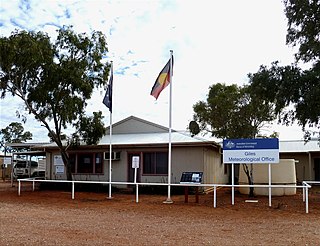
The Gunbarrel Highway is an isolated desert track in the Northern Territory, South Australia and Western Australia. It consists of about 1,350 km (840 mi) of washaways, heavy corrugations, stone, sand and flood plains. The Gunbarrel Highway connects Victory Downs in the Northern Territory to Carnegie Station in Western Australia. Some sources incorrectly show the highway extending west to Wiluna.
Warburton or Warburton Ranges is an Aboriginal Australian community in Western Australia, just to the south of the Gibson Desert and located on the Great Central Road and Gunbarrel Highway. At the 2016 census, Warburton had a population of 576.

The Shire of Ngaanyatjarraku is a remote local government area in Western Australia near the Northern Territory/South Australian border. It is 1,542 km (958 mi) from Perth.

The Great Central Road is a mostly unsealed Australian outback highway that runs 1,126 km (700 mi) from Laverton, Western Australia to Yulara, Northern Territory. It passes through a number of small communities on the way.
Ngaanyatjarra is an Australian Aboriginal language. It is one of the Wati languages of the large Pama–Nyungan family. It is one of the dialects of the Western Desert Language and is very similar to its close neighbour Ngaatjatjarra, with which it is highly mutually intelligible.

The Ngaanyatjarra, also known as the Nana, are an Indigenous Australian cultural group of Western Australia. They are located in the Goldfields-Esperance region, as well as Northern Territory.
Ngaatjatjarra is an Australian Aboriginal dialect of the Western Desert language. It is spoken in the Western Desert cultural bloc which covers about 600 000 square kilometres of the arid central and central-western desert. It is very similar to its close neighbours Ngaanyatjarra, Pitjantjatjara and Pintupi, with which it is highly mutually intelligible.

Aṉangu Pitjantjatjara Yankunytjatjara, also known as APY, APY Lands or the Lands, is a large, sparsely-populated local government area (LGA) for Aboriginal people, located in the remote north west of South Australia. Some of the Aṉangu (people) of the Western Desert cultural bloc, in particular Pitjantjatjara, Yankunytjatjara and Ngaanyatjarra peoples, inhabit the Lands.
Kiwirrkurra, gazetted as Kiwirrkurra Community, is a small community in Western Australia in the Gibson Desert, 1,200 kilometres (750 mi) east of Port Hedland and 700 kilometres (430 mi) west of Alice Springs. It had a population of 165 in 2016, mostly Aboriginal Australians. It has been described as the most remote community in Australia.

Giles Weather Station is located in Western Australia near the Northern Territory border, about 750 kilometres (470 mi) west-south-west of Alice Springs and 330 kilometres (210 mi) west of Uluru. It is the only staffed weather station within an area of about 2,500,000 square kilometres (970,000 sq mi) and is situated mid-continent and near the core of the subtropical jetstream. This means it plays an important role as a weather and climate observatory for the country, particularly eastern and southeastern Australia, and particularly for rainfall predictions. The station is on the Great Central Road and the nearest township is the Warakurna Aboriginal settlement, 5 kilometres (3 mi) North. Giles is within the Shire of Ngaanyatjarraku and is in the foothills of the Rawlinson Ranges.
Wingellina or Irrunytju Community is a small Indigenous Australian community in Western Australia located about 1,700 kilometres (1,056 mi) north east of Perth near the Western Australian-South Australian border in the Goldfields–Esperance region of Western Australia. The local language of Wingellina is Pitjantjatjara.
Papulankutja is a large Aboriginal community located in the Goldfields–Esperance region of Western Australia, within the Shire of Ngaanyatjarraku.
Tjukurla is an Aboriginal community, located in the Goldfields-Esperance region of Western Australia, within the Shire of Ngaanyatjarraku.
Tjirrkarli is a medium-sized Aboriginal community, located in the Goldfields–Esperance region of Western Australia, within the Shire of Ngaanyatjarraku.
Mantamaru is a medium-sized Aboriginal community, located in the Goldfields–Esperance region of Western Australia, within the Shire of Ngaanyatjarraku.
Patjarr is a small Aboriginal community, located near the Clutterbuck Hills between Lake Cobb and Lake Newell, 243 kilometres by road north west of Warburton in the Goldfields–Esperance region of Western Australia.
Wanarn is a medium-sized Aboriginal community, located in the Goldfields–Esperance region of Western Australia, within the Shire of Ngaanyatjarraku.
The Ngaanyatjarra, Pitjantjatjara and Yankunytjatjara Women's Council is a community-based community organisation formed in 1980 delivering services to the Ngaanyatjarra, Pitjantjatjara and Yankunytjatjara women in the central desert region of Australia across the borders of the Northern Territory, South Australia, Western Australia with its headquarters in Alice Springs. It provides a range of community, family, research and advocacy services.
The Ngaatjatjarra are an Indigenous Australian people of Western Australia, with communities located in the north eastern part of the Goldfields-Esperance region.
Tjapartji Kanytjuri Bates (c.1933–2015), also spelt Taparti, was an Australian Aboriginal artist based in Warakurna, Wanarn, and Warburton communities in the Gibson Desert. She was of the Ngaanyatjarra people. Known to be active from 1991, her work incorporates media of paint, canvas, glass and felt, and is particularly centred around interpretations of Tjukurrpa from her mother and father.







